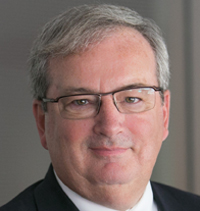Thirteen years ago this Thursday our world changed. The unimaginable happened. We will never forget that morning: where we were, who we were with, what we saw, what we said, what we did, how we reacted, how we mourned, and how we came together. Those thoughts came back to me this morning when I heard Mike Causey’s Federal News Radio promo: “9/11/01 – Where Were You?” I hope people will participate and share their stories so that we can continue the mosaic collection that forms the picture of our lives today in a post-9/11 world.
Last week, I had the privilege of touring part of the World Trade Center site in New York. It was crowded with people of all nationalities and occupations. Construction workers went about the process of rebuilding as tourists stood in line to visit the National September 11 Memorial Museum. Outside on the plaza, visitors watched the flowing fountains of the Memorial as business executives walked by, occasionally looking out over the World Trade Center campus. Elders told the youngsters stories of where they were, who they were with, what they saw and how their lives had been affected by the events that occurred there. The place is one where an unspeakable tragedy occurred; yet, the rebuilding helps create a hopeful environment. It is odd how those senses seem to follow each other.
Telling stories is how we convey our emotions from one generation to the next. Pictures alone cannot capture the feelings we had then or now. We are a people who need to tell and hear stories. Yet, sometimes those stories are very hard to tell because they are too personal and too painful. My father, for example, rarely talked about his experience as an Army sergeant in World War II. He would answer questions when he was asked, of course, but it was only around his Army buddies that he would openly share stories of the people and events that occurred (occurred to them collectively) when they were serving their country’s call to sacrifice their time, capability and, if necessary, their lives to defend freedom. They had a shared bond: they understood what it was like to be there when the action was intense, the smells were strongest, the sounds were loudest and the threats were all too real.
A few weeks ago my Uncle Ralph died at age 95. He was at Pearl Harbor on December 7, 1941. While he was not on one of the ships that was attacked, he witnessed it and had many friends who died that day. He lived long enough to see the world escape from the evil horrors that started a world war. He also lived long enough to see America rebound from that attack and establish solid, positive, long-term relationships with both Japan and Germany. He was a man who looked at adversity and still had hope in the future. He was an inspiration to our family and to many others who learned about him through the stories of his life.
Yes, there have been many stories written about how the 9/11 of our generation was the December 7 of my Dad and Uncle’s generation. If these stories help us remember the sacrifices, response and recovery, then it does not matter that the parallels aren’t exactly perfect.
Plus, we know our experiences are not unique to us. There are thousands of stories passed down from one generation to the next. The 9/11 Museum has collected stories of the victims and their families. The same thing has occurred, on a slightly smaller (but no less important) scale in Shanksville, PA and in Arlington, Virginia at the Pentagon.
It is imperative that we keep on living, moving forward, and applying lessons learned from the experiences we have and the stories we hear. We must always remember. We can never forget.


